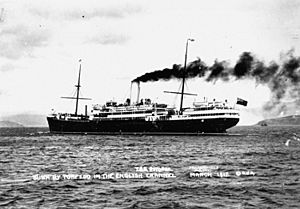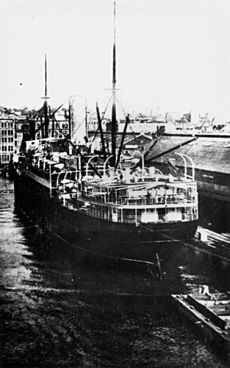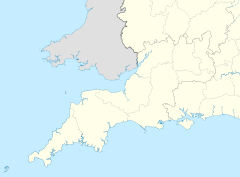SS Rotorua (1910) facts for kids

Rotorua
|
|
Quick facts for kids History |
|
|---|---|
| Name | Rotorua |
| Namesake | Rotorua |
| Owner |
|
| Operator |
|
| Port of registry | Plymouth |
| Route |
|
| Builder | Wm Denny & Bros, Dumbarton |
| Cost | £172,483 |
| Yard number | 915 |
| Launched | 9 July 1910 |
| Completed | 8 October 1910 |
| Identification | |
| Fate | sunk by torpedo, 22 March 1917 |
| General characteristics | |
| Type | ocean liner |
| Tonnage | 11,130 GRT, 7,094 NRT, 10,600 DWT |
| Length | 484.2 ft (147.6 m) |
| Beam | 62.3 ft (19.0 m) |
| Draught | 29.4 ft (9.0 m) |
| Depth | 41.1 ft (12.5 m) |
| Decks | 3 |
| Installed power | 605 NHP, 8,631 ihp |
| Propulsion |
|
| Speed | 15 knots (28 km/h) |
| Capacity |
|
| Crew | 144 |
| Armament | (as DEMS): 1 × 4.7-inch gun |
| Notes | sister ships: Ruahine, Remuera |
The SS Rotorua was a large ocean liner and reefer ship (a ship that carries refrigerated cargo) built in Scotland in 1910. It was owned by the New Zealand Shipping Company. Sadly, a German U-boat (submarine) sank the Rotorua in 1917 during the First World War.
It's interesting to know that there was another ship named Rotorua later on. That ship was built in 1911 and was also sunk by a U-boat in 1940 during World War II.
Contents
Building the Rotorua
The New Zealand Shipping Company ordered the Rotorua to be a sister ship to Ruahine, which was built in 1909. Both ships were constructed by William Denny and Brothers in Dumbarton, Scotland.
The Rotorua was launched on July 9, 1910, by Mrs. George T. Haycraft, whose husband was a director of the New Zealand Shipping Company. The ship was finished and ready to sail by October 8, 1910.
The Rotorua was 484.2 ft (147.6 m) long and 62.3 ft (19.0 m) wide. It weighed 11,130 GRT gross tons. At the time, it was the biggest ship ever built in Dumbarton!
Unlike its sister ship Ruahine, which had two propellers, the Rotorua had three. Two of its propellers were powered by special steam engines. The steam from these engines then went on to power a third propeller with a steam turbine. This design was first used on another New Zealand Shipping Company ship called Otaki.
Together, the engines produced a lot of power, allowing the Rotorua to reach a top speed of 15.77 knots (29.21 km/h) during its tests.
The Rotorua had huge cargo holds. About 299,540 cubic feet (8,482 m3) of space was for refrigerated cargo, mostly for frozen mutton (lamb meat). Another 194,180 cubic feet (5,499 m3) was for regular cargo. It also had cranes that could lift heavy items, up to 25 tons.
The ship could carry 580 passengers:
- 52 in first class
- 88 in second class
- 440 in third class
It also carried 14 lifeboats and two smaller whaleboats for safety. Because the Rotorua was a bit wider than the Ruahine, its public rooms, like the lounges, were also a bit bigger. It even had a special nursery for children and a pipe organ in the first-class dining room!
The Rotorua was registered in Plymouth, England. Its official identification number was 124587, and its code letters were HRSG.
Life Before the War

In October 1910, the Rotorua was shown to the public in London. Its first journey, called its maiden voyage, started from London on October 27. It stopped in Plymouth two days later, then in the Canary Islands, Cape Town, and Hobart. The ship finally arrived in Wellington, New Zealand, on December 11. This arrival was big news! The trip from England took 42 days and 20 hours.
In early 1911, some Irish politicians, including John Donovan, Richard Hazleton, and William Redmond, traveled on the Rotorua. They were going to Tasmania and New Zealand to ask for support for Irish home rule, which meant Ireland would govern itself.
The Rotorua visited Auckland, New Zealand, for the first time on May 18, 1911. There, it was also put on public display for people to see.
Another sister ship, the Remuera, was launched in May 1911. The Remuera was even bigger than the Rotorua. This meant the Remuera became the largest ship built in Dumbarton and the biggest in the New Zealand Shipping Company's fleet.
In 1913, the New Zealand Government tried an experiment. They shipped 3,000 eggs to England on the Rotorua. The eggs were kept cool at 45 °F (7 °C) during the long 16,000-nautical-mile (30,000 km) journey. When they arrived in London six weeks later, reports said they were "in splendid condition."
By 1914, the Rotorua had wireless telegraphy equipment, which allowed it to send and receive messages using radio waves. The Marconi Company operated this equipment. The ship's call sign was MKE.
The First World War and the Rotorua
When the First World War started on July 28, 1914, the Rotorua was sailing across the Atlantic Ocean towards England. For safety, it was told to stay in a neutral port called Santa Cruz de Tenerife for a few days. Then, it was instructed to continue its journey with all its lights turned off. It reached Plymouth and London safely.
During the war, the Rotorua sometimes changed its route to avoid danger. For example, on a trip to New Zealand in October 1914, it skipped calling at Cape Town. In July and August 1915, it didn't stop at Santa Cruz de Tenerife. These changes were made to keep the ship safe during wartime.
To protect itself, the Rotorua was fitted with a 4.7-inch gun at the back of the ship. This made it a defensively armed merchant ship.
By March 1915, the Rotorua had "F 529" painted on its sides. The "F" meant it was carrying food, which was very important during the war. This mark helped the ship get priority for things like piloting and getting fuel.
In February 1916, the Rotorua helped bring 203 New Zealand soldiers back home. These soldiers had been injured and discharged from hospitals in the UK. They shared the third-class area with 130 other passengers.

In September or October 1916, the Rotorua used the Panama Canal for the first time. It was on its way to London. Important passengers on board included New Zealand Prime Minister William Massey and his Minister of Finance Joseph Ward. Mr. Ward was very impressed with the canal. He believed it would be a huge help for trade with New Zealand.
On December 24, 1916, another ship, the Maitai, got stuck on a reef near Rarotonga. It was carrying passengers and a lot of mail, including letters from soldiers overseas. The Rotorua was sent to help. It arrived on December 31, picked up the Maitai's passengers, and loaded the mail.
The Rotorua was supposed to go to Wellington, but because of the rescue, it changed course to Auckland. It arrived there on January 8. Again, there were wounded soldiers on board who were returning from France.
The Loss of the Rotorua
On February 3, 1917, the Rotorua left Wellington, New Zealand, with a full load of frozen food and other goods. It stopped in Newport News, Virginia, and then reached Plymouth, England, in March. All 264 passengers got off the ship there.
The Rotorua then left Plymouth, heading for London. But on March 22, 1917, a German submarine, SM UC-17, attacked it. The submarine sank the Rotorua with a torpedo in Lyme Bay, about 24 nautical miles (44 km) east of Start Point, Devon.
As the crew were leaving the sinking ship, one of the stewards accidentally fell overboard. Sadly, he was the only person who died in the attack.
In its short life of seven years, the Rotorua had completed 13 round trips between England and New Zealand. Its loss was a big blow to the New Zealand Shipping Company. Just 12 days earlier, another of their ships, the Otaki, had been sunk by a German merchant raider in a gun battle.
Today, the wreck of the Rotorua lies on its side at the bottom of the sea, at a depth of 144 to 213 feet (44 to 65 m). It is now a popular spot for divers to explore. Divers have even found and recovered the ship's bell!
Images for kids



